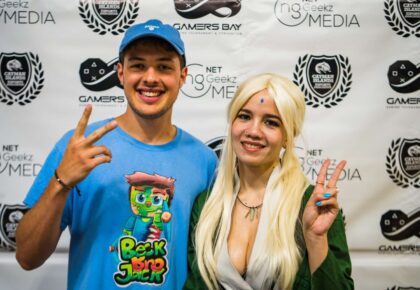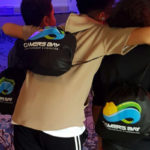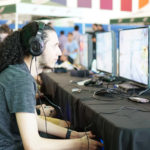Ever since gamers could first go head-to-head in video games like 1962’s Spacewar and 1972’s Pong, gaming has been the stage for an endless competition. That competition began to attract attention—and money—in the United States during the 1980s. Across the globe, electronic contests grew in size and spectacle in the ‘90s, and then exploded in the new millennium.
Many millions of players flocked to the most competitive games—Quake, Street Fighter, Starcraft, Counter-Strike, League of Legends and more—where competition is so organized, popular, and skill-intensive that it has earned the name “esports.”
Esports is global industry supported by sponsors, teams, leagues, fans and, of course, the professionals who compete at the highest levels and make a living from prize winnings and endorsement deals.
Who are the most important players in esports history, and how can we evaluate them?
Though they made their marks on different games during different eras, these 10 players possess a combination of skill, star power, and influence on esports history that makes them the greatest of all time. They’ve pushed their teams, their games, and all of esports into new territory.
It would be impossible to put these people head to head—but that’s the fun of an all-time top 10 list. It’s meant to start a conversation. Comparing players across different times and games is an invitation to debate.
10) Moon
Jang Jae-Ho (Moon) is the greatest Warcraft 3 player of all time.
While Grubby won events around the world, Moon won championships in South Korea, the Mecca of eSports. From near the beginning of Warcraft 3’s competitive scene, Moon consistently won against the best competition available anywhere. No one else could make that claim. He became a global icon in the process. In a game that gives players control over four possible races, Moon became known as the 5th Race.
Some Grubby and Sky fans may still challenge Moon’s claim as the most skilled player of all time, but he is certainly the most important Warcraft player ever, bar none. On top of his competitive success, Moon belongs in the history books because of the record-breaking contract he received in 2009. He had been the best player in the world for nearly seven years, and was rewarded with a $500,000 contract with the Korean team WeMade FOX. This salary reflected his global success and status and, most of all, his immense popularity in Asia.
Moon’s salary only makes sense in the context of a series of enormous investments into esports during 2008 and 2009. Newer, more mainstream titles such as Guitar Hero 2, Fight Night 3, Counter-Strike: Source and World of Warcraft were pushing their way into major esports competitions, often with help from the bank accounts of major media corporations. When mountains of money did not equal high viewership and attendance, sponsors soured on the esports industry as a whole.
Entire teams and leagues collapsed. Warcraft 3 suffered a particularly gruesome fate thanks to the artificial inflation of player salaries, of which Moon’s was the highest by far. His salary and, moreover, the environment in which it grew, helped destroy much of the old world of esports and create the landscape in which pro gaming exists today.
However, while misguided investments led to the downfall of Warcraft 3’s competitive scene, Moon himself carried on for several years by winning several major tournaments to shore up his title as Warcraft’s best of all time.
Highlights:
Moon vs. Grubby, MBCGame WarCraft 3 World War 2007
Moon vs. Sky, IEF final 2008
9) Jaedong
Lee “Jaedong” Jae Dong is probably the best Zerg player to have ever played Starcraft: Brood War. One could argue that Ma “sAviOr” Jae-Yoon was the most important Zerg player thanks to his creativity and ingenuity, but even so one would be hard-pressed to not consider Jaedong his heir apparent.
Between 2007 to 2011, Jaedong won two MBCGame Starleagues, three OnGameNet Starleagues, and three World Cyber Games-titles. This alone made him one of the strongest players to have ever touched the game.
In total, Jaedong made nine separate StarLeague finals. In these finals, he only lost to two opponents in total: At the 2008 Arena MSL, he lost to Terran-player Park “ForGG” Ji Soo. The four others saw his greatest rival, and the greatest Starcraft player of all time, Lee “Flash” Young Ho, dispatch of the king of Zerg.
Taking place during the game’s twilight, the rivalry between Jaedong and Flash is one of the most celebrated rivalries in all of esports. That the two were able to consistently perform to such a level that they made the finals of the biggest individual leagues in South Korea is testament alone to the level they were performing at. Whether it was in the StarLeagues, World Cyber Games, or ProLeague (South Korean team league), the two were locked into a seemingly eternal battle for supremacy over the most demanding esports title in history.
But sharing the stage is not the same thing as showing up, and despite Jaedong’s incredible run as one of the greatest-ever, one is still left wondering about what his legacies would have been had Flash’s prime not coincided with his.
8) Dendi
Danil “Dendi” Ishutin is a household name in esports and especially Dota 2. Together with Na`Vi, which has been his team of choice for more than six years, Dendi set the standard of how to play as a midlaner. Excelling on playmakers such as Puck and Pudge, Dendi was one of the few players in Dota 2’s early days that could single-handedly take over games on a consistent basis—earning him the unadulterated love of commentators, fans, and even other players.
For seven years, the Ukrainian Dota 2 superstar has remained a consistent talking point within the community. That’s thanks largely to the incredible success Na`Vi experienced between 2011 to 2013. In these two years alone, Na`Vi won The International 2011, 13 LAN events, and placed within the top three of both The International 2012 and 2013.
These are results few other players in the history of esports can contend with. But not even listing the events can do true justice as to why Dendi is a one-of-a-kind type of player. One simply has to watch the insanity for yourself:
As with many champions, however, his period at the very top of the game was fleeting. Long stretches of success have often followed by an equal level of struggle. But even with his best days seemingly behind him, there’s no denying Dendi his place among the greatest esports players of all time.
7) Fatal1ty
Jonathan Wendel (Fatal1ty) is the most important player that the United States has ever produced. In terms of prize money, he’s the single highest earner in esports history. America’s first true celebrity gamer, the height of his fame in the early 2000s remains beyond the reach of any American to this day.
Wendel’s competitive career began in 1999 with a $500 tournament win in Quake 3. The next few months saw him take home $4,000 in Dallas and then $15,000 in Sweden, where an 18-game winning streak made him the best-known Quake star at the time.
Behind the passion and pleasure of play, Fatal1ty always saw gaming as a job. He practiced longer and smarter than any of his rivals, and the results bore that out as he won tournament after tournament—including five total world championships in 1999, 2000 (in which he won two), 2001 and 2005. Wendel actively sought out and secured major sponsorship deals for himself and built the Fatal1ty brand to heights that no eSports individual, team, or league had reached before.
Wendel appeared in the New York Times, Forbes, 60 Minutes, Time and, most memorably, MTV’s True Life series, which followed his first place Unreal Tournament 2003 run at Winter CPL 2002 as part of an hour-long episode on gamers.
Wendel was a catalyst for the first wave of truly professional eSports in the West. As games like Quake and Counter-Strike and leagues such as CPL conquered Europe and America in the 2000s, even your parents might have recognized Fatal1ty’s face.
Highlights:
Fatal1ty vs makaveli, CPL 2000 Finals, Quake 3 Arena
Fatal1ty vs Vo0, CPL 2005 Finals, Painkiller
Fatal1ty vs PC Gamer staff, 2007
6) f0rest
Counter-Strike is an iconic game in esports history. It was the most important game in the West for a decade starting in 1999, and boasted more than its fair share of legends. Names such as Heaton, SpawN, elemeNt, and ksharp just scratch the surface of a list of enormous talents who helped change the public perception of pro gaming in America, Europe, and beyond.
Patrik Lindberg (f0rest), now 28, hails from Sweden, one of the most successful gaming nations of all time. F0rest’s greatest accomplishment is likely his monstrous 2009 run on team Fnatic, in which his perfect play pushed the team to become the highest-earning in Counter-Strike history at a time when many observers worried the game was on its deathbed. For a period, Lindberg was perhaps the most celebrated esports figure outside of Asia.
Since breaking into high-level play in 2005, f0rest has always ranked among the most feared and respected players in his game. With over 50 gold medals to his name, no one blinked an eye when former teammate Patrik “cArn” Sättermon called f0rest the game’s greatest player. Any survey of Counter-Strike players and fans finds countless agreement.
Like Grubby, f0rest has a big extra tack on his resume. Not only is he the greatest Counter-Strike player of all time, his performance in Counter-Strike: Global Offensive, the game’s sequel, was one of the major factors behind NiP’s absurd 87-0 streak of map wins on LAN. The greatest streak in esports history.
In the five years since the game’s general release, f0rest still remains as one of Sweden’s most valuable CS:GO players. A testament to one of the true lifers in esports.
Highlights:
fnatic.f0rest vs SK, IEM III Global Challenge Montreal Grand Final 2008, Counter-Strike 1.6
2009 f0rest highlight film, Counter-Strike 1.6
f0rest’s 65-18 run vs fnatic, Copenhagen Games 2013, Counter-Strike: Global Offensive


5) Daigo
Tomo Ohira became the first king of Street Fighter by dominating the game during the birth of esports in California, but the biggest unanswered question of Tomo’s career has always concerned the player widely considered to be Street Fighter’s all-time greatest: Could Tomo beat Daigo?
Japan’s Daigo Umehara was one of esports’ first global stars. His 1998 trip to America to defeat Alex Valle in Street Fighter Alpha 3 marked the beginning of a storied international rivalry that would define the most important fighting game franchise ever.
Known as The Beast, Umehara’s arcade obsession began in 1991 and continued through his teenage years as he began to pile up the wins. Daigo became Japan’s Street Fighter national champion in 1997.
At this point, the Japanese and American fighting game scenes rarely interacted. As when Tomo Ohira reigned only a few years earlier, each scene was something of a question mark to the other. Major international tournaments had not been firmly established, and competition between the two continents was extremely limited.
The 1998 world championship marked the beginning of a globally competitive era that had big implications beyond Street Fighter. Umehara’s victory in what was then the most highly anticipated match in fighting game history kicked off a long career of dominance.
Daigo has competed at the highest levels in over a dozen games, from Vampire Hunter to Street Fighter 5. He moved from merely the greatest Street Fighter player in the world and catalyst for global esports competitions to a genuine international celebrity when a he won 2004 match against Justin Wong in thrilling style.
The American publication GamePro has compared the 2004 Daigo/Wong moment to Willie Mays’ famous over-the-shoulder catch in the 1954 World Series, a spectacular act that has come to define not just a game, but an entire era in the sport.
The preceding accomplishments alone would likely be enough to land Daigo on this list, but there’s so much more. He has continued his high level of play for more than 15 years, winning world championships as recently as his famed repeat performance at Evo 2009 and 2010. He’s got two Topanga A League titles and two Topanga World League titles and placed second at Capcom Cup 2015 (then donated his $60k prize to a scholarship fund).
Very few players can match Daigo’s résumé, and there is simply no one else with the inhuman longevity that The Beast possesses.
Highlights:
Daigo vs Justin Wong, Evo 2009 Finals, Street Fighter 4
Daigo vs Ricky Ortiz, Evo 2010 Finals, Street Fighter 4
Daigo vs Alex Valle, 1998 Capcom World Championships, Street Fighter Alpha 3
4) Boxer
At one point, Lim Yo Hwan (SlayerS_BoxeR) was the greatest player in esports history.
From its 1998 release through 2010, Starcraft was the greatest esport on the planet. While other games struggled to hold regular tournaments and had to beg for sponsors, South Koreans packed stadiums and held Starcraft competitions with more than 100,000 screaming fans in the audience. No other game on earth could compare. Fans of Counter-Strike and Quake spoke about Korean Starcraft like the stuff of legend because, for them, it was. Much of what today’s most successful esports have accomplished was done first in South Korea.
With the world’s fastest growing economy for much of the 1990s, South Korea’s tech-savvy youth embraced professional gaming and enabled its evolution into a major sport with legitimate superstars. Although many of the players became celebrities, Boxer stands out as something like a Michael Jordan of esports.
Boxer won his first major tournament in 1999. He turned the game on its head, pushing the underpowered Terran race to its biggest successes ever. His first nickname was “The Hope of Terran.”
South Korea’s Starleague, the most difficult and important esports tournament of its time, was Boxer’s stomping ground. He beat his greatest rival, “The Storm Zerg” Yellow, to earn the first of two Starleague titles in a row, a feat that wasn’t matched until Jaedong did it in 2009. He conquered the World Cyber Games in 2001 and 2002, cementing his international fame. He continued to win and contend for championships until 2004. Boxer’s rivalries with players such as Nada and iloveoov rank among the most memorable in esports history. He went on to sign a $180,000 contract— a record at the time —and had a global fan club of 500,000 members.
Beyond his considerable genius for Starcraft, Boxer was a symbol. Imagination, artistry, charisma, and skill allowed him to comfortably slip out of the simple box of “gamer” and into the expansive idea of greatness. His success and, even more important, the flair with which he succeeded, were proof to millions that some games possessed a depth, richness and future that could not be denied.
“In the NBA, Michael Jordan was but one athlete, but had the influencing power beyond that of a mere basketball player,” wrote PGR21.com’s Seiji. “It is safe to say that because of his presence, the NBA grew rapidly and basketball was no longer the American game, but an international sport. Would it be an overstatement if one were to say that Lim Yohwan has a value like Michael Jordan? The greatest significance Lim Yohwan has towards e-sports is that he has transformed it from a festival of mere maniacs to a mainstream culture that is now broadcasted by the media. His value can be seen as he raised the understanding of what was once considered as a mere childish game to the dignified acceptance by all as part of the mainstream culture.”
More than just about anyone else in history, Boxer made the leap from player to genuine cultural icon, and drove the global success of esports.
Highlights:
The Greatest Starcraft match ever – SlayerS Boxer vs Joyo, Round of 16, OnGamenet Starleague 2003
3) GeT_RiGhT
In 2009, only two years after debuting on the competitive Counter-Strike 1.6 circuit, Christopher “GeT_RiGhT” Alesund ascended into the presence of Counter-Strike royalty. After spending two years fighting for a permanent spot in Sweden’s top teams, the then 19-year-old player was picked up by Fnatic. But despite being surrounded by stars such as f0rest, Patrik “cArn” Sättermon, and Rasmus “Gux” Ståhl—it was GeT_RiGhT that came to define Swedish Counter-Strike 1.6.
Pioneering what is today commonly known as “lurking,” GeT_RiGhT capitalized on any opportunity that his team provided him. The combination of exquisite aim, his keen sense of awareness, and movement made him a terrifying foe who could not only open up bombsites on his own, but could always seem to find a way out of the bleakest situations.
GeT_RiGhT’s time in Fnatic was a monstrous success, as the Swede won 10 events during his first year with the team. The following year proved to be less fruitful, and in 2011 both GeT_RiGhT and f0rest competed alongside SK Gaming for about a year-and-a-half. At this point, the success GeT_RiGhT had experienced was more than most esports competitors could have dreamed of. But as it turns out, things were just getting started for the Swede.
With the release of Counter-Strike: Global Offensive, GeT_RiGhT established himself as the best player in the world within a few months. Competing alongside f0rest once again, the two players made up one of the strongest duo out of any esport, as they tore all opposition apart.
For consistently raising the bar over the span of a decade, GeT_RiGhT is bestowed with a top three placing among the best esports players in history.
2) Flash
From 1998 to 2010, South Korean Starcraft was the most highly competitive gaming scene on the planet. Starcraft had the money and status to create and maintain a vibrant ecosystem for over a decade. Television broadcasts and net cafes wove the game into the fabric of South Korean life. While other games gingerly stepped into the spotlight, Starcraft hit the ground running and never stopped.
The most dominant, highest-earning Starcraft player of all time is Lee Young Ho (Flash), with over $400,000 in tournament wins and hundreds of thousands in contracts and endorsements. In the most widely watched, closely scrutinized, high pressure game on the planet, Flash reigned above all.
Flash owns an absurd 70 percent win rate against the world’s top competition, holds the record for highest rating of all time, shares the record for longest tenure as the #1 ranked player in the world, and is tied for most Starleague wins in a single year, reports Liquipedia. For many modern esports fans, Flash embodies both genius and dominance.
Lee Young Ho once went by nicknames such as “Final Boss” and “The Ultimate Weapon,” but as his list of accomplishments grew, fans started calling him something more simple and to-the-point: God.
Highlights:
Flash vs Jaedong, WCG Korea 2010
The Ultimate Weapon, 2009 highlights
Flash vs. Best, Proleague 2011
1) Faker
If Boxer was the Michael Jordan of esports in his role as an ambassador for the game, then Lee “Faker” Sang-hyeok is the Michael Jordan of esports on the playing field.
The League of Legends superstar is the best player ever in the largest and most competitive esport in history, reigning over a scene that has truly reached professional sporting levels of competition. Not only is Faker a true outlier, supremely talented at a level above his peers, he’s seeing unprecedented success in a game that mitigates the impact of the individual player.
In League, teamwork, strategy, and coordination matter above all. Unless you’re playing against Faker.
The then-17-year-old Faker burst onto the scene in 2013, a youngster scouted by the biggest esports team in Korea, SK Telecom, and tabbed to push them to relevance in League of Legends. In the Spring season, Faker led SKT to a third-place finish while garnering respect as potentially the best mid laner in the world as only a rookie. In the Summer, SKT took the title and ran that success all the way to winning the World Championship at the Staples Center in Los Angeles.
Since then, Faker is synonymous with success. He’s one of only two League of Legends players to win three World titles, the other being his former teammate Bae “Bengi” Seong-woong. Faker has won six domestic titles since entering the scene, three of which were consecutive victories. He’s won every international tournament in League, including IEM, All-Stars, the Mid-Season Invitational, and the World Championship.
He’s the only esports player to grace the cover of ESPN’s Magazine. He’s earned more prize money than any other League player by far, his $1 million is nearly $200,000 more than the next earner. When EDward Gaming beat SK Telecom T1 at the Midseason Invitational in 2015, the only blemish on Faker’s resume since failing to qualify for the 2014 World Championship, it was legendary not because SKT lost, but because they lost while fielding Faker’s Leblanc, at the time undefeated in 12 professional games.
The fact that a player like Faker exists in a game like League shows the skill inherent in the endeavor, why fans enjoy watching it, why they revere it as a sport. While Boxer was a phenomenon within Korea, leading the esports revolution in what is now the greatest esports nation in the world, Faker is serving that role on a global scale.











